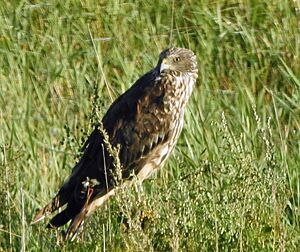Eastern marsh harrier facts for kids
Quick facts for kids Eastern marsh harrier |
|
|---|---|
 |
|
| Conservation status | |
| Scientific classification | |
| Genus: |
Circus
|
| Species: |
spilonotus
|
The eastern marsh harrier (Circus spilonotus) is a cool bird of prey. It belongs to a group of birds called harriers, specifically the marsh harrier type. People used to think it was the same species as the western marsh harrier. But now, most scientists agree it's its own separate species.
This bird has two main groups, called subspecies. One group, C. s. spilonotus, lives in eastern Asia. The other, C. s. spilothorax, lives in New Guinea. This second group is also known as the Papuan harrier. Some even think the Papuan harrier might be a separate species too!
What Does the Eastern Marsh Harrier Look Like?
This harrier is about 48 to 58 cm (19 to 23 inches) long. Its wings can spread out from 113 to 137 cm (44 to 54 inches) wide. Just like many birds of prey, the female harrier is usually bigger than the male.
The male's plumage (which means its feathers) can look different from bird to bird. Usually, its head, chest, back, and wing-coverts (feathers covering the wings) are dark, almost black, with lighter streaks. The rest of its wings are grey, with black tips and a white front edge. Its tail is grey, and its rump (the lower back) is white. The underside of its body is mostly white.
Female eastern marsh harriers are dark brown. They have light brown streaks on their heads and undersides. Their rump is often whitish, and their tail has dark stripes. Young harriers are dark brown. They have light brown on their heads and a pale patch under their wings.
This bird is usually quiet. But it does make a "mewing" sound. You'll hear this sound most often when the birds are resting together.
Where Do Eastern Marsh Harriers Live?
Most eastern marsh harriers are migratory. This means they travel long distances between their breeding and wintering grounds. However, the Papuan harrier group stays in one place all year.
They breed in places like north-east China, Mongolia, and south-east Siberia. You can find them as far west as Lake Baikal. A small number also breed in northern Japan, especially in Hokkaidō and northern Honshū. Sometimes, eastern and western marsh harriers meet near Lake Baikal. When they do, they can sometimes have babies together.
When winter comes, these birds fly south. Their winter homes include southern China, Taiwan, Korea, and southern Japan. They also go to northeast India, Bangladesh, and Southeast Asia. Some even fly as far south as the Philippines, Borneo, and Sumatra. Many thousands of these birds fly along the Chinese coast. You can see huge numbers passing through places like Beidaihe in the autumn.
Eastern marsh harriers like open areas. This includes marshland, paddy fields (rice fields), and grassland.
What Do Eastern Marsh Harriers Eat and How Do They Raise Their Young?
When hunting, the eastern marsh harrier flies low over the ground. It holds its wings in a slight V-shape. It likes to eat small mammals, other birds, and frogs.
The breeding season for these harriers starts in April. They build their nests on the ground. The nests are made of sticks and are usually found in reedbeds. A female harrier will lay four to seven eggs. The parents take turns sitting on the eggs for 33 to 48 days to keep them warm. This is called incubation.
Once the young birds hatch, they stay in the nest for about 35 to 40 days. After this time, they are ready to fly on their own. This is called fledging.


